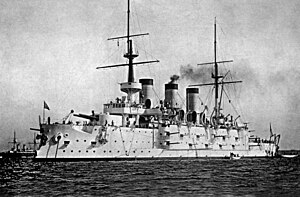Russian battleship Pobeda
 Pobeda as the Japanese battleship Suwo in 1908
| |
| History | |
|---|---|
| Name | Pobeda |
| Builder | Baltic Works, Saint Petersburg, Russia |
| Laid down | 1 August 1898 |
| Launched | 24 May 1900 |
| Commissioned | 31 July 1902 |
| Fate | Sunk, 7 December 1904 |
| History | |
| Name | Suwo |
| Acquired | Refloated, October 1905 |
| Commissioned | October 1908 |
| Stricken | 1922 |
| Fate | Broken up, 1946 |
| General characteristics | |
| Class and type | Peresviet-class battleship |
| Displacement | 13,500 long tons (13,717 t) |
| Length | 129.2 m (424 ft) |
| Beam | 21.8 m (71 ft 6 in) |
| Draught | 8.3 m (27 ft 3 in) |
| Propulsion | list error: <br /> list (help) 3 shaft reciprocating vertical triple expansion (VTE) engines 30 Miyabara boilers 14,500 shp (10,800 kW) |
| Speed | 16 knots (18 mph; 30 km/h) |
| Range | 6,000 nmi (11,000 km) at 10 kn (12 mph; 19 km/h) |
| Complement | 732 |
| Armament | list error: <br /> list (help) • 4 × 254 mm (10 in) guns • 10 × 152 mm (6 in) guns • 16 × 12-pounder guns • 21 × 3-pounder guns • 8 × 1½-pounder guns • 2 × torpedo tubes |
| Armour | list error: <br /> list (help) Belt: 230 mm (9 in) Deck: 70 mm (2.76 in) Conning tower: 254 mm (10 in) |
IRN Pobeda was one of eight Russian pre-dreadnought battleships captured by the Imperial Japanese Navy during the Russo-Japanese War of 1904-1905. She was sunk, and then salvaged and renamed as IJN Suwo (周防).
Russian career
Pobeda was built as the Peresviet-class battleship and commissioned into the Imperial Russian Navy in 1903. It was one of Russia's first ships to mount quick-firing guns. It had a high forecastle and secondary guns mounted on two decks, and armor that stretched the entire length of the hull. It was designed with heavy main armament and high speed, but proved unsatisfactory in service.
The Pobeda was damaged first by gunfire off Port Arthur, then by a mine. She took 11 hits at the Battle of the Yellow Sea, and while back at Port Arthur for repairs she was repeatedly hit by Japanese shore batteries. On 7 December 1904, Japanese siege guns finally sank the vessel.
Japanese career
Salvaged after the war in October 1905, she was refloated, repaired, and taken into service as the Suwo, taking her name from Suo Province, now part of Yamaguchi Prefecture.
After reconstruction at Yokosuka with Japanese boilers and guns, the Suwo was re-designated as a 1st class coastal defence ship in October 1908. She served in this role for many years, and received a refit in 1912. In World War I, during the Battle of Tsingtao from 27 August 1914, the Imperial Japanese Navy sent a squadron of ships under Vice-Admiral Sadakichi Kato, flying his flag in the Suwo, to blockade the coast of German-controlled Kiaochow. The British Royal Navy attached the China Station's pre-dreadnought HMS Triumph and the destroyer HMS Usk to the Japanese squadron, which consisted of mostly obsolete warships, and several modern ones such as the seaplane carrier Wakamiya, dreadnoughts Kawachi and Settsu, and the battlecruiser Kongō for this operation.
After the war, the Suwo was assigned to training for cadets and engineers. She became a gunnery training ship in 1917. In 1922, the Suwo was disarmed at Kure. During this process, on 13 July, the old vessel capsized. The hull was righted and the turrets, machinery, and main armor removed, but oddly work stopped there. The hulk was towed to Mitsugojima, were it remained throughout the Pacific War as a storage hulk. In 1946, the hulk was towed back to Kure and broken up for scrap.

References
- Gibbons, Tony: The Complete Encyclopedia of Battleships and Battlecruisers
- Burt, R.A.: Japanese Battleships, 1897–1945
